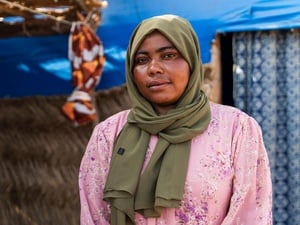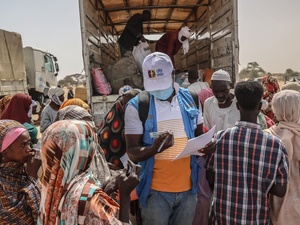Feature: Relocated Eritrean refugees find a second home in Sudan
Feature: Relocated Eritrean refugees find a second home in Sudan

A young Eritrean enjoying her new home at Um Gargour. The tent in the background is for temporary shelter until the new arrivals build their huts.
KHARTOUM, Sudan (UNHCR) - Mohamed Ibrahim looked unsure as he stared out of a bus that was taking him and his family on a dusty, 180-km journey from Um Broush to Um Gargour refugee camp in eastern Sudan.
"I don't know what to expect," said the 28-year-old mechanic. "My family has lived in Um Broush camp since 1969. I was born there, and so were all my brothers and sisters."
Mohamed was one of some 3,000 Eritrean refugees who were relocated from six camps to Um Gargour as part of a camp closure and consolidation programme in June.
It all started when the UN High Commissioner for Refugees announced in 2002 that the reasons that had prompted Eritreans to take refuge in other countries no longer exist as fundamental and durable changes have occurred with the end of the 30-year war with Ethiopia in 1991 and Eritrean independence in 1993. Similarly, peace has returned with the signing of a cease-fire agreement between Ethiopia and Eritrea in June 2000 and the establishment of a UN-supervised security buffer zone between the two countries.
As a result, Eritreans were told that they would lose their refugee status on December 31, 2002, and asked to make one of three choices. The first option was to register for voluntary repatriation if they wanted to go home. Under the return programme, UNHCR would help to transport them with all their belongings back to Eritrea, and upon arrival, provide them with basic start-up assistance to reintegrate in society.
Of the 100,000 camp-based Eritrean refugees in Sudan, some 36,000 opted for repatriation.
The second option was to apply for continued asylum. This choice was for refugees who feared persecution for political, ethnic, religious or other reasons if they went home. They were asked to go through legal screening by international and Sudanese lawyers to determine the validity of their claims for further asylum in Sudan. If accepted, they would continue enjoying refugee status. If rejected, they could appeal, and failing that, they could still join those who were returning home with UNHCR assistance.
About 28,000 registered to be screened - more than 10,000 cases have already been heard and adjudicated so far, of whom about 4,000 were accepted to stay as refugees.
The third option was to apply for legal residence in Sudan through immigration channels. This was for Eritrean refugees who had developed social and economic links in Sudan and who wanted to stay in their host country.
Mohamed and his family - comprising his mother, five siblings and a young nephew - were among those who were accepted for continued asylum.
"I think this is not a bad place after all," said Mohamed upon arriving at Um Gargour camp. "It is nearer to Kassala town where I work. I can come and visit my family more often here."
When they first arrived, they were very moved by the warm welcome by existing refugees at Um Gargour, as well as officials from UNHCR and the Sudanese government's Commission for Refugees (COR). Everyone was invited to dinner, and despite the fact that more than 500 tents had been erected to house them, the newcomers were invited to spend their first night in the homes of the existing refugees.
"This is very encouraging. They made us feel at home right from the start," said Mohamed, who added that some of the local residents had offered to help him build a hut for his family.
Each refugee family was allocated about 400 square metres of land to build their homes. The UN refugee agency provided water and sanitation facilities, while the local schools arranged to work in two shifts to accommodate the newcomers. In addition, with UNHCR funding, COR agreed to build one hut for each family in addition to the ones built by the refugees themselves.
All recognised refugees receive food from the UN World Food Programme. And in the long run, refugees are encouraged to become self-sufficient by cultivating land provided by the Sudanese government.

Each refugee family is allocated about 400 square metres of land to build their homes.
Overall, the camp closure and consolidation process aims to bring together those who were granted continued asylum in camps like Um Gargour. Those who were rejected, as well as those who registered for voluntary repatriation, will be housed in temporary camps.
The relocation operation will unfold in three phases. The first phase occurred from June 3 to July 4, and resulted in the closure of six camps. The second phase is scheduled to start in September after the rainy season, and the third phase in 2004. The whole process is expected to end in late 2004, leaving just two camps for Eritrean refugees in Sudan.
By Khalid Abdu Dahab
UNHCR Sudan









